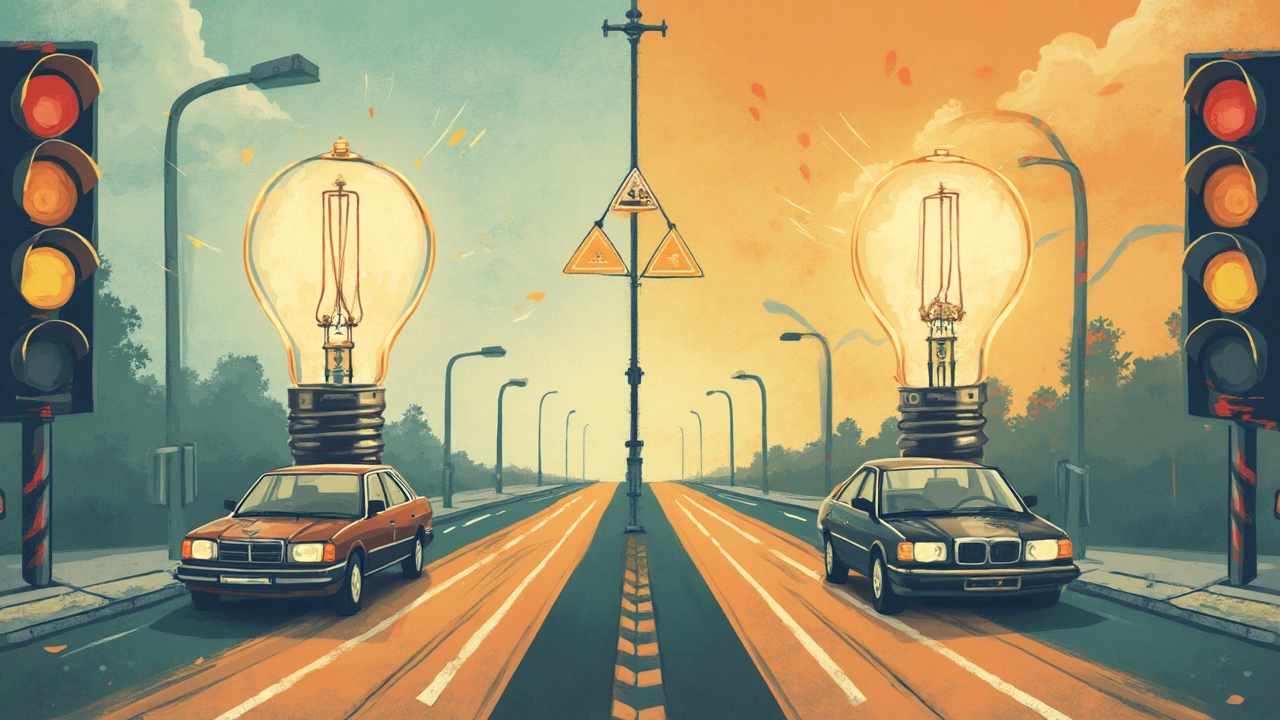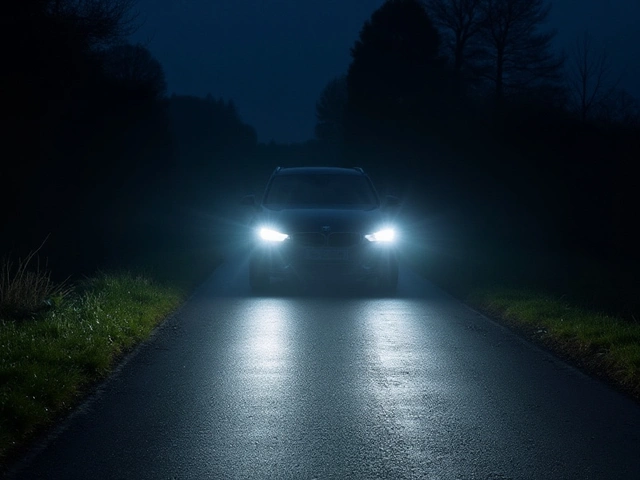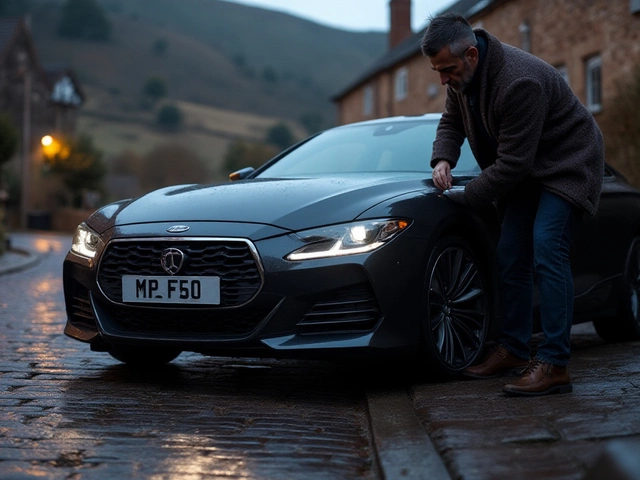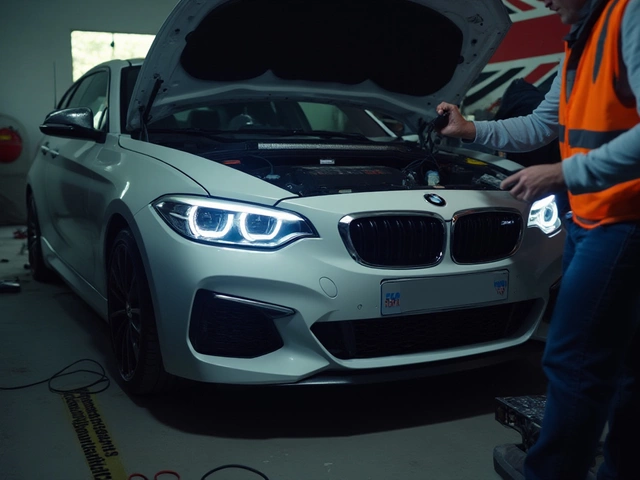Driving around with the brightest headlights can sound pretty tempting, especially when LED bulbs promise to light up the road like it's daytime. But here's the catch—not all LED bulbs are street legal, and using the wrong ones can land you in trouble.
So why are some LED bulbs not ready for road duty? It boils down to a mix of regulations, safety concerns, and how these bulbs actually work. Let’s kick things off by looking into what LED headlights are and why they're all the rage lately.
LED, or Light Emitting Diode, bulbs have found their way into just about everything that lights up your life. They use less power and last way longer than those old-school bulbs. But when it comes to headlights, there's more in the spotlight than just energy saving and lumens.
- Understanding LED Headlights
- The Legal Landscape
- Safety Concerns
- Choosing Legal Options
- Future of LED Headlights
Understanding LED Headlights
LED headlights have become all the rage, and for good reasons. They offer a modern look, consume less energy, and typically last longer than traditional halogen bulbs. What makes LED bulbs unique is the way they produce light. Instead of using a filament like old-school bulbs, LEDs generate light through electroluminescence. This means they convert electricity directly into light, making them incredibly efficient.
But efficiency isn't the only thing these bulbs bring to the table. They also tend to offer better brightness and color temperature range. Ever noticed how some LED headlights look almost blue-white compared to the yellowish hue of halogen lights? That's because LEDs often hit the 6000K mark on the color temperature scale, giving a daylight-like appearance.
However, not every LED bulb can just pop into any vehicle headlight socket. Vehicle lighting systems are designed to work with specific types of bulbs, and compatibility is a pretty big deal. While some cars come equipped with factory-installed LEDs, swapping out halogens for aftermarket LEDs requires consideration of both the bulb fit and the vehicle’s electrical system.
Here's a quick fact: LEDs often boast a lifespan up to 25,000 hours compared to the typical 2,000 hours of halogen bulbs. So while they might cost more upfront, they definitely pay off over time with less frequent replacements.
So, why aren’t all LED headlights hitting the road legally? It’s not just about fitting them into your car's headlight unit. Regulations come into play, dictating aspects like brightness levels and beam patterns to ensure safety for oncoming traffic.
The Legal Landscape
When it comes to making sure your car’s lights are street legal, there’s a web of rules and regulations you gotta navigate. In most places, what makes an LED bulb fit for the road isn’t just brightness—it's all about how well it fits into the existing headlight system and complies with local laws.
First off, the brightness. Sure, an incredibly bright LED bulb might seem like a good idea, but if it's blinding oncoming traffic, that's a problem. Most jurisdictions set limits on how much light, measured in lumens, can come out of your headlights. It’s not a free-for-all.
There's also the issue of beam pattern. LED bulbs need to project light in a specific way to avoid creating hotspots or glare, both of which can be dangerous. Traditional halogen systems are designed with specific reflectors that work with those bulb types. Throwing an aftermarket LED into that mix can mess with this balance unless the LED is specifically designed to mimic halogen light distribution.
Many states in the U.S., for instance, adhere to standards set by the Department of Transportation (DOT) that dictate these criteria. LED bulbs that are designated street legal are often marked with a DOT symbol. So, before you slap those new bulbs in, make sure to look for that magic acronym.
- Check for 'DOT Approved' markings on LED packages.
- Ensure wattage and lumens comply with local limits.
- Use bulbs that are specifically designed for headlight use.
Fitting proper lighting isn't just about matching the specs; it's also about safety—for you and everyone else on the road. Keeping your modifications legal not only helps you avoid pesky fines but also keeps roadways safer for night drivers.

Safety Concerns
When thinking about swapping out your headlights for some modern LED bulbs, it’s important to know why not all of them are street legal. Sure, you want better visibility, but at what cost? The major gripe with non-compliant LEDs is how they can actually end up blinding other drivers on the road. Let’s dig into why this happens.
One big issue with some LED headlights is their intensity and how the light is distributed. Unlike standard bulbs, LEDs can create hotspots – areas that are much brighter than others – which can be blinding to oncoming drivers. This isn't just annoying; it can genuinely lead to accidents.
There’s also the concern of glare. Remember, it's not just about lighting up the road for yourself but ensuring your lights aren't causing issues for everyone else. Here’s the kicker: glare from LEDs tends to be more intense, and drivers are more affected, especially at night.
Another safety factor is the color temperature of LED bulbs. Most halogens project a warm yellow hue, while LEDs often emit a blue-white light. This shift can affect depth perception and the ability to see objects clearly against the backdrop of the road.
Finally, investing in proper installation is crucial. Slapping on any old LED headlights without aligning them correctly can lead to misdirected beams, which again, causes unnecessary dangers.
- Ensure lights are properly aligned to avoid blinding other drivers.
- Choose LED bulbs with regulated beam patterns.
- Opt for bulbs with an appropriate color temperature for driving comfort.
Choosing Legal Options
Navigating the world of LED bulbs for your car can be a bit like shopping for shoes online—you think they look great, but you need to make sure they actually fit. The key is making sure your choice meets the legal requirements for street legal use.
First, check if your chosen LED headlights are DOT (Department of Transportation) approved. This certification ensures they meet the necessary safety standards. It's not just about brightness; it's about ensuring they won't blind other drivers or leave too many dark spots on the road.
Also, pay attention to the headlight assembly type on your vehicle. Some assemblies are specifically designed for halogen lights, and switching to LEDs might require a complete change of the headlight housing to maintain proper beam patterns and avoid glare.
Here’s how you can make sure you’re choosing the right option:
- Research the Requirements: Look up your state's specific lighting regulations. Some regions have different rules about brightness levels and color temperatures.
- Buy from Reputable Brands: Stick to well-known brands that clearly state their bulbs are DOT-approved or compliant with your country’s safety standards.
- Consider Professional Installation: It might cost a bit more, but having a professional install your LEDs can ensure everything is set up correctly and legally.
A little research can save you from hefty fines and make sure your nighttime drives are safe for you and everyone else on the road. The right headlight regulations compliance makes all the difference in keeping your vehicle both stylish and safe.

Future of LED Headlights
As time marches on, the landscape for LED headlights continues to evolve rapidly. With technology racing forward like a sprinter, what's coming next could reshape how we see the road, literally and legally. So, what's on the horizon?
One of the biggest leaps we might see is the integration of smarter technology into LED bulbs. Advanced adaptive lighting systems are already bubbling up in high-end cars, and soon enough, they might become the norm. Imagine headlights that adjust automatically based on road conditions or turn their beam as you steer. Pretty cool, right?
Then, there’s the push for standardization. As the demand for car lighting that meets both energy efficiency and safety standards grows, a unified global standard might emerge. This could make it much simpler for consumers to get road-legal LEDs without playing the guessing game.
Of course, manufacturers are all eyes on the LED headlight market. They're continuously working on designs that maximize brightness without causing glare—one of the big reasons some LED headlights aren't street legal right now.
In terms of numbers, some industry forecasts suggest that LED technology could dominate up to 70% of the headlight market by 2030. This shift could drive prices down even further, making LED options more accessible to everyone.
Vehicle enthusiasts and everyday drivers alike are watching closely, ready for the moment when updating to the latest LED headlights becomes as easy as swapping out a light bulb in the kitchen. It's a bright future, quite literally!




